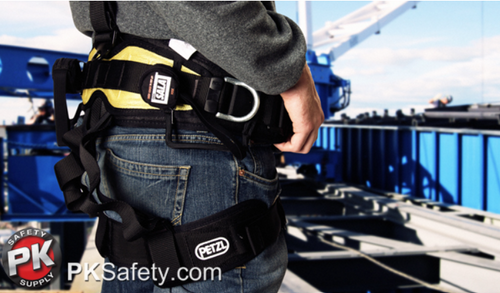Suspension Trauma Straps Can Fit Most Harnesses
Workers and employers are becoming more aware of the problems associated with suspension trauma (also called orthostatic intolerance) which can affect a fall victim who is held aloft by their full-body harness. What people have been asking with some regularity lately is if the suspension trauma straps from one company will work with a harness from another. The answer, as far as we can tell with the products we have tried and the manufacturers we've talked to, is yes.
Last week a customer wrote to ask if her Petzl AVAO Harness would work with the Suspension Trauma Straps from DBI-SALA. It's a good question because, unlike many vest-style harnesses like some of the ExoFit harnesses from DBI-SALA, there isn't an obvious point of attachment. With a vest style harness, the webbing forms a cross on the sides of the body at the hip. The trauma straps are attached to the webbing coming from the back of the harness and above the intersection. For the Petzl harness, suspension trauma devices can attach to the webbing of the waist belt behind the positioning D-rings or to these lateral D-rings themselves. By positioning the straps here, when a fallen worker steps into the loops after they are deployed, the weight is transferred to the feet and the dorsal D-ring where the fall protection is attached and removes it from the straps putting pressure on the main arteries in the legs.
Miller also makes Suspension Relief Steps that have similar attachment capabilities. No matter where these straps come from, they aren't going to put you in the most comfortable position. It's not like sitting on your couch watching the game. But it can save your life in these serious situations. The straps we tried from both DBI-SALA and Miller can be attached to just about any full-body fall protection harness.
The reason for these straps is that once you've fallen in a harness, you may find yourself becoming lightheaded or dizzy; you may pass out entirely. The blood being pumped through your body is restricted by the pressure of the harness straps around the legs. The body senses that the flow of blood is restricted and wants to get things flowing again. As a last-ditch effort to resume that blood flow, the body may blackout in the hope that a blackout will result in the body falling to a horizontal position and will create a better path for blood flow.
If a worker is held aloft by a lanyard or an SRL attached to the dorsal D-ring of the harness, the worker is not going to become horizontal if they pass out. They are simply going to dangle, and the pressure will continue against those blood superhighways. If rescue does not come quickly enough, serious injury or even death can occur when oxygen-starved organs become damaged.
Trauma straps are a very simple solution to this situation. Whichever brand of harness or straps you choose, the important thing is to install them now. This isn't an article you want to remember when you are 20 feet off the ground, wishing you had taken care of it sooner.
Recent Posts
-
Promoting Safety: National Work Zone Awareness Week is April 15-19, 2024
Each year, the National Work Zone Awareness Week (NWZAW) places the spotlight on the importance o …Apr 11th 2024 -
Understanding 4 Gas Monitors: How They Work & Why They Are Important
In today’s increasingly dynamic industrial landscape, 4 gas monitors have emerged as critical com …Apr 8th 2024 -
April Showers Require Workers to Wear Hi-Vis Safety Rain Gear
While April showers bring May flowers, they also bring challenges, particularly for those working …Apr 1st 2024





